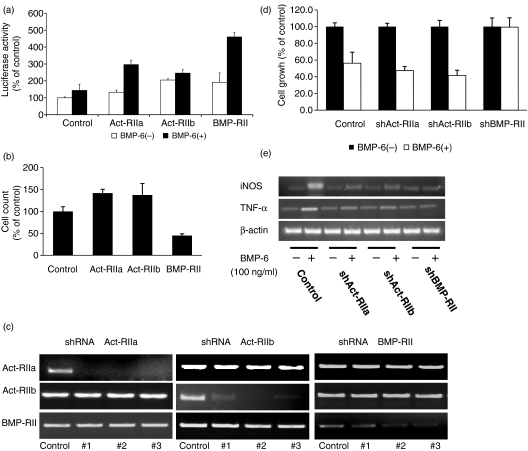Figure 4.
Functional type II bone morphogenetic protein (BMP) receptor in RAW 264·7 cells. (a) Cells were transfected with each of the three type II BMP receptors along with the reporter plasmid BMP response element-luciferase (BRE-luc). Following treatment with BMP-6, all three type II receptors increased the luciferase activity in transfected cells. However, cells transfected with BMP-RII demonstrated the highest level of luciferase activity. (b) Following transfection with each of the three type II BMP receptors, cells were treated with BMP-6 at 100 ng/ml. At the end of a 48-hr period, the effect on cell count was determined. As expected, only the proliferation of cells transfected with BMP-RII was inhibited with BMP-6. Cells transfected with the empty expression vector pcDAN3·1 and treated with BMP-6 were used as the control. To control for varying transfection efficiency, cells were co-transfected with the reporter construct CMV-LacZ. (c) RAW 264·7 cells were transfected with lentiviral constructs containing short hairpin RNA (shRNA) targeting each of the three BMP type II receptors. Three sequences were tested for each of the type II BMP receptors. The effect on the levels of expression of the target was determined by reverse transcription–polymerase chain reaction (RT-PCR). Con, control; #1, #2 and #3, clones 1, 2 and 3, respectively. (d) RAW 264·7 cells were transfected with lentivirus containing a shRNA sequence targeting each of the type II BMP receptors. Subsequently, cells were treated with 100 ng/ml of BMP-6 for 48 hr. The results demonstrated that BMP-6-induced growth inhibition was reversed only when the expression of BMP-RII was knocked down. (e) Induction of iNOS and TNF-α was investigated in shRNA transfected cells. ShBMP-RII completely blocked induction of inducible nitric oxide synthase (iNOS) and tumour necrosis factor (TNF)-α. However, the shRNA construct of activin (Act)-RIIa and Act-RIIb only partially blocked the induction of iNOS and TNF-α.

